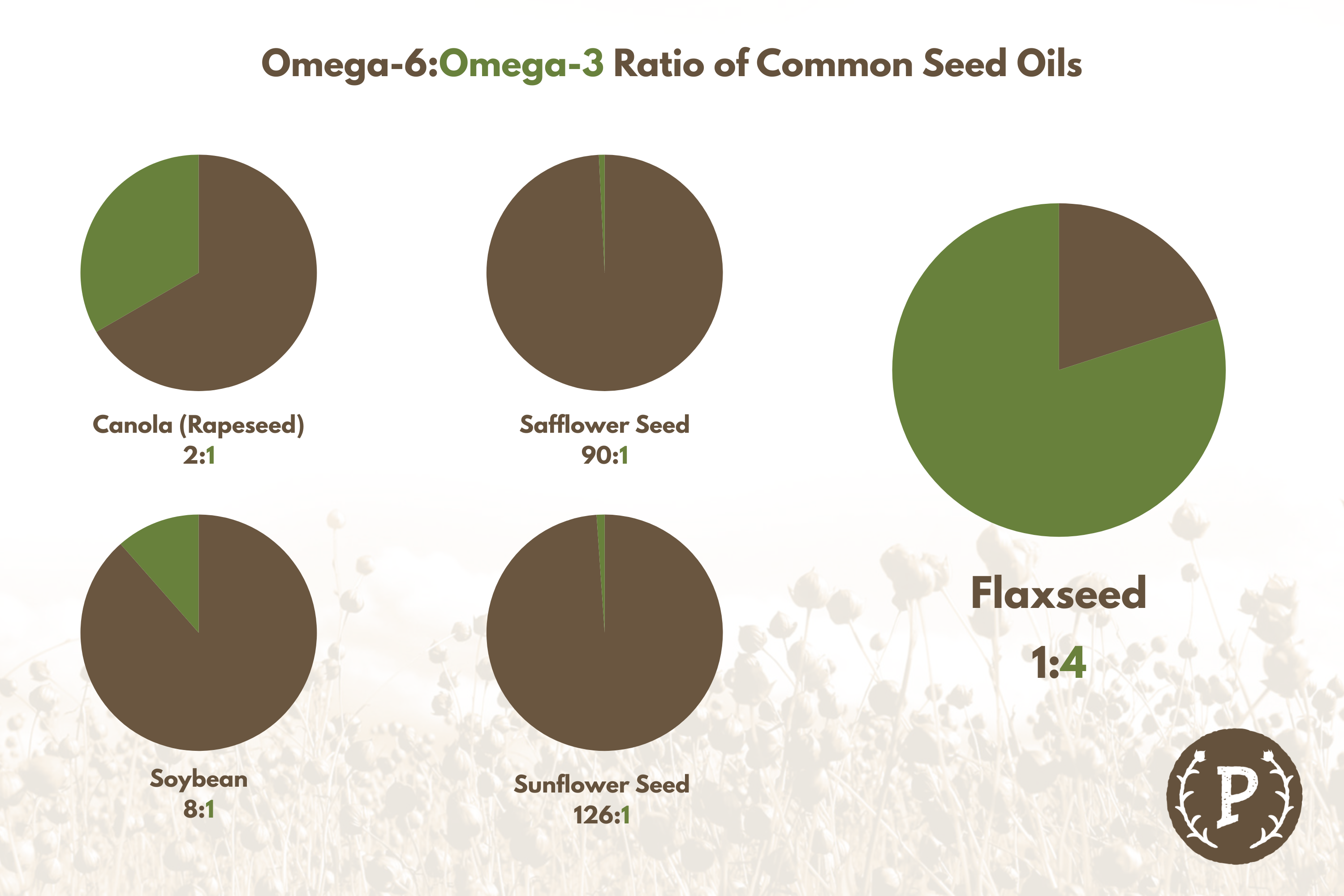What Are Seed Oils?
Over the course of the last century, seed oils have replaced animal fats as the primary oils used for cooking. These oils have become ubiquitous in restaurants and home kitchens and in processed foods.
The term “seed oil” is a generic term encompassing oils made from various plants including vegetables, nuts, seeds, and legumes. Some of the most common seed oils include1:
- Canola (Rapeseed Oil)
- Corn Oil
- Cottonseed Oil
- Soybean Oil
- Sunflower Oil
- Safflower Oil
- Grapeseed Oil
- Rice Bran Oil
What’s the Concern?
Recently, there has been a trend amongst health-conscious individuals, especially on social media platforms, to either reduce or eliminate seed oils in their diet. There are two main reasons for this: 1. Many seed oils contain high amounts of omega-6 fatty acids which can be inflammatory when overconsumed in proportion to omega-32; 2. Seed oils are highly processed.
Omega-6: Omega-3 Ratio & Inflammation
Omega-6 is a natural, healthy polyunsaturated fatty acid which is necessary for your body’s proper functioning. However, because omega-6 plays a role in the synthesis of pro-inflammatory molecules3 in your body, consuming too much omega-6 in proportion to omega-3, may promote a chronic inflammatory response. Acute inflammation is crucial when you get sick or hurt, but chronic inflammation can be dangerous and has been linked to numerous diseases.
Omega-3 plays an equally important yet different role in the body. It is believed to have anti-inflammatory effects and is a building block for every cell in your body and is important for arterial wall function4.
Unfortunately, many seed oils have very high amounts of omega-6 and little omega-3. The huge amount of seed oils we consume in our modern diet, coupled with low intake of omega-3 rich foods such as flaxseed, walnuts, and fish, have led to a high ratio of omega-6:3 in the general population. It is estimated that humans evolved on an omega-6:3 ratio of 1:1 or 2:1. However, today’s average omega-6:3 ratio is somewhere around 20:14.
Processing
Seed oils are usually highly processed, meaning that much of the plant’s original nutritional components may be lacking in the finished product5. Seed oils are often refined, bleached and deodorized to give them a longer shelf-life and make them both colorless and odorless. Furthermore, sometimes chemical solvents are added during oil extraction and then removed later in processing. While these methods have been deemed safe by health authorities, it is unsettling for some.
Flaxseed Can Help Reverse Negative Effects of High Omega-6 Intake
Fortunately, some seeds, such as flaxseed, can help balance a high omega-6:3 ratio. Flaxseed has an omega-6:3 ratio of about 1:4 which means that it can help increase omega-3 levels in proportion to omega-6. Omega-6 is healthy and necessary, so it is important not to cut it out entirely. Adding more omega-3 into your diet can help offset any negative effects of too much omega-6. Two tablespoons of flaxseed per day can add 3,000mg of omega-3 into your diet. For perspective, the average American gets around 160-200mg of ALA omega-3 per day6.
Pizzey Ingredients milled flaxseed does not undergo heavy processing either. We clean the flaxseed from foreign objects or debris using manual removal methods, put it through our heat treatment process to make it safe for ready-to-eat products (if applicable), and then gently mill it while preserving the beneficial ALA omega-3 and antioxidants inside. This method keeps all the original nutritional components of the flaxseed intact.

Notes
[1] Alison Kane, RDN, LDN, “Seed Oils: Facts & Myths,” Massachusetts General Hospital, Published October 2024. https://www.massgeneral.org/news/article/seed-oils-facts-myths
[2] Abeba Haile Mariamentatu, Emebet Mohammed Abdu, “Overconsumption of Omega-6 Polyunsaturated Fatty Acids (PUFAs) versus Deficiency of Omega-3 PUFAs in Modern-Day Diets: The Disturbing Factor for Their ‘Balanced Antagonistic Metabolic Functions’ in the Human Body,” Journal of Lipids, March 2021, doi: 10.1155/2021/8848161
[3] Julie Corliss, “Seeding doubt: The truth about cooking oils,” Harvard Medical School, Published March 2025, https://www.health.harvard.edu/heart-health/seeding-doubt-the-truth-about-cooking-oils
[4] “Omega-3 Fatty Acids,” Pizzey Ingredients, Accessed April 2025, https://pizzeyingredients.com/omega-3/
[5] “Processing Edible Oils”, PennState Extension Service, Updated November 2022, https://extension.psu.edu/processing-edible-oils
[6] “Omega-3 Fatty Acids”, National Institutes of Health, Accessed April 2025, https://ods.od.nih.gov/factsheets/Omega3FattyAcids-HealthProfessional/